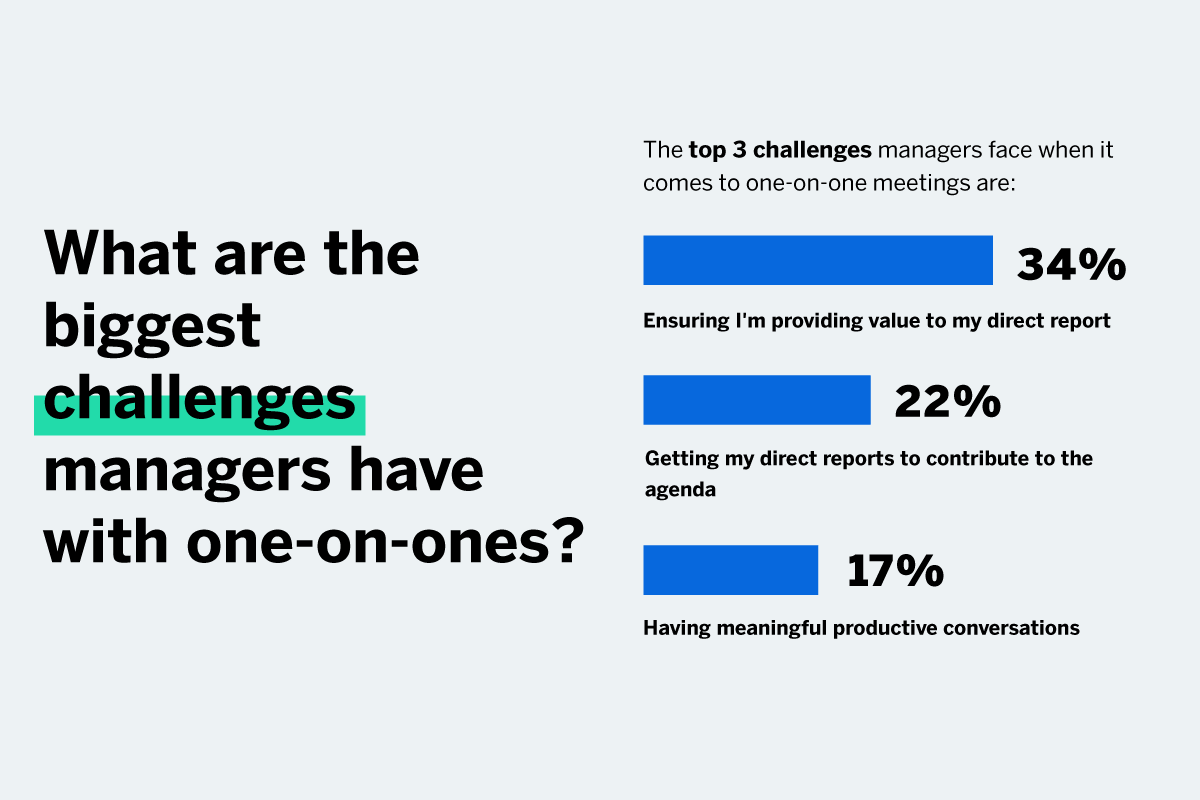What is a one-on-one meeting?
One-on-one meetings are simply meetings between two individuals, usually a manager and a direct report or team member. One-on-one meetings can also be between a team member and one of their peers, a coach or a mentor.
They are a great vehicle to help your employees stay connected to their purpose and the meaning of their work in the context of the organization and team. Most people enjoy being heard and recognized as an individual and this is where the power of one on ones lies:
- They keep your employees engaged, and productive
- They build rapport between manager and team
- They demonstrate that the company cares about, and values, their employees
Free eBook: Improve employee experience by empowering your managers
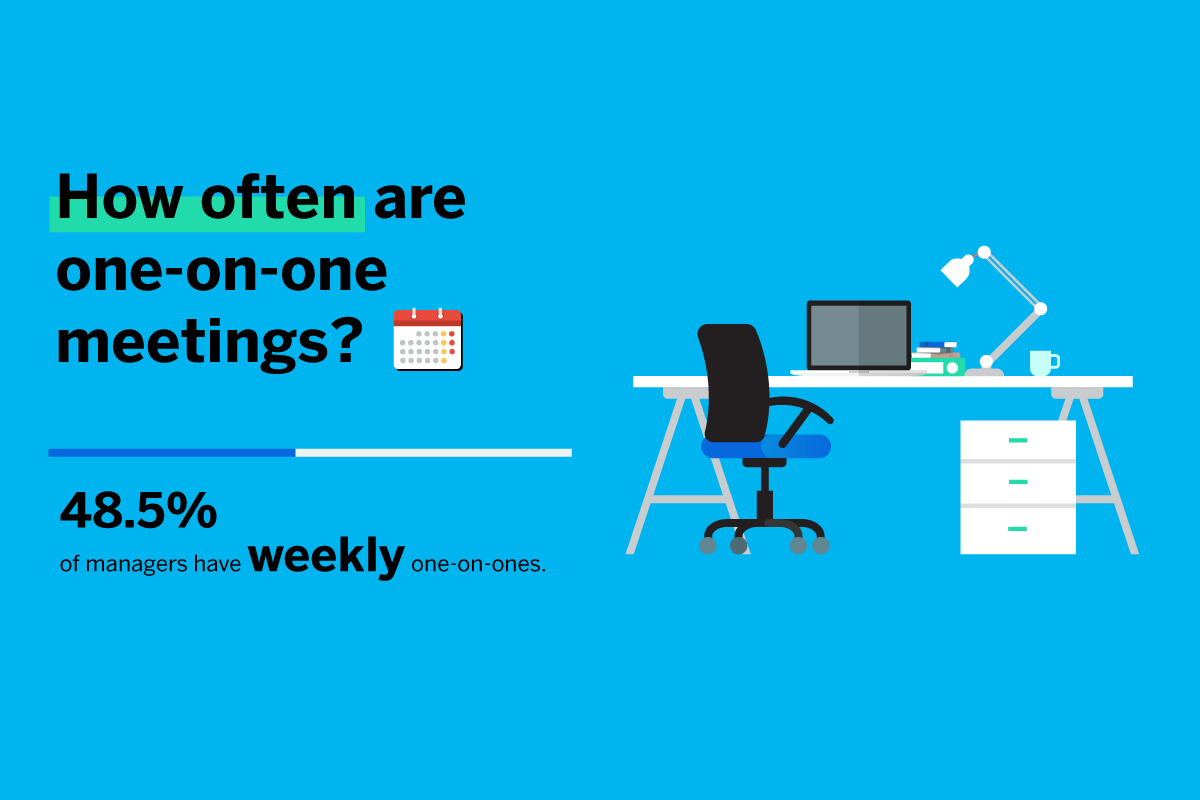
What’s the purpose of one on one meetings?
Two words: listening, and clarification. And it’s the manager who should do 90% of the listening and 10% of the talking. Everybody needs to be clear on what they’re doing, in every aspect of their working life.
One-on-one meetings are the perfect arena for employees to ask direct questions that they may have been embarrassed to ask in a more public setting.
You can also use that dedicated time in one on one meetings to:
- Get to know direct reports better at a personal level
- Understand and eliminate ‘roadblocks’
- Give and receive feedback
- Take a ‘pulse check’ on how an employee is feeling
- Coach team members to develop them and help their performance
- Connect employees to the organization’s mission, purpose, and goals
- Get a personal perspective on key projects
- Identify action items through discussion points
- Get a status update from an individual’s perspective
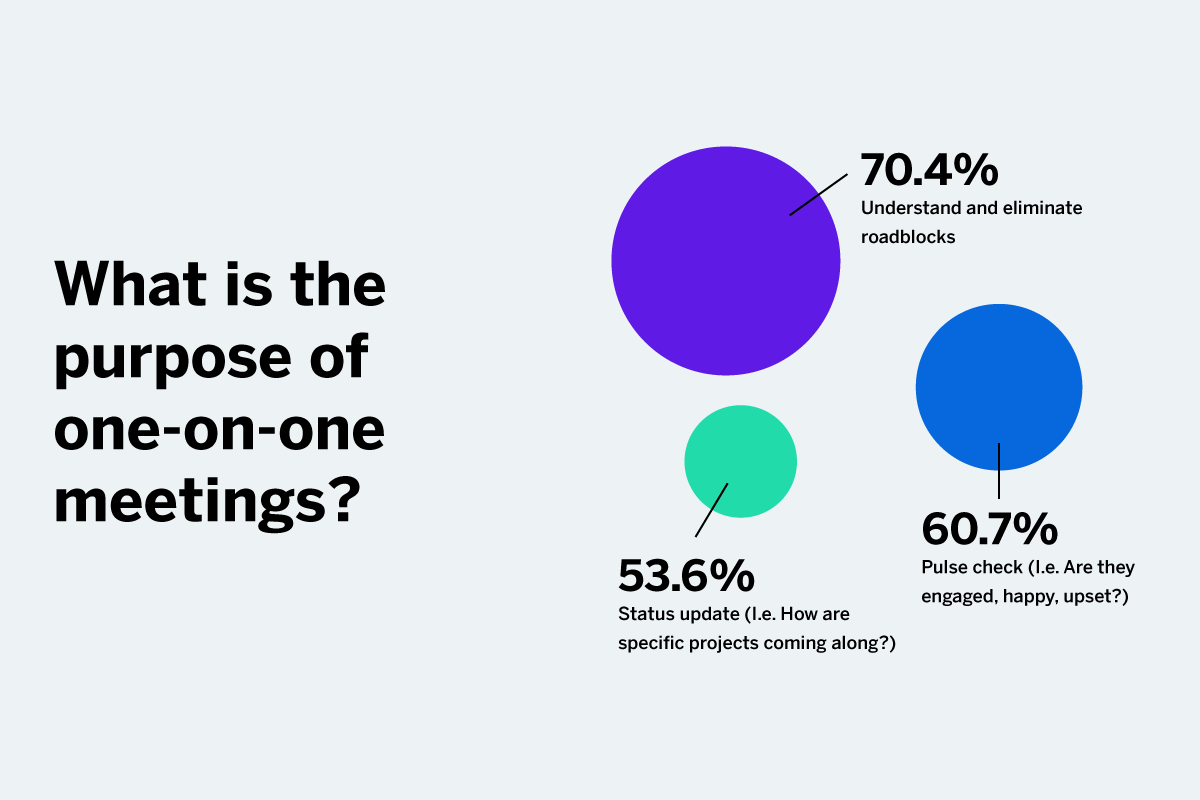
The benefits of one on one meetings
Although they are time-consuming, one on one meetings are immensely valuable – for managers and employees alike.
They build trust
Regularly-scheduled, honest discussions build trust between employers and managers. And when team members trust each other, it creates a safe environment where people can express themselves, innovate, and be their authentic selves.
They develop managers’ leadership and coaching skills
These skills are essential in the modern world of work, and managers who are good at them are highly sought-after. The one-on-one meeting skills of being able to actively listen, and provide pertinent feedback and guidance develop the manager’s coaching abilities. And better coaches support employees to better performance.
They improve employee engagement, productivity, and performance
According to the Harvard Business Review: ‘employees who got little to no one-on-one time with their manager were more likely to be disengaged. On the flip side, those who get twice the number of one on ones with their manager relative to their peers are 67% less likely to be disengaged.’
And Gallup demonstrates that engaged workforces perform better and are more productive than disengaged ones, positively impacting key business outcomes:
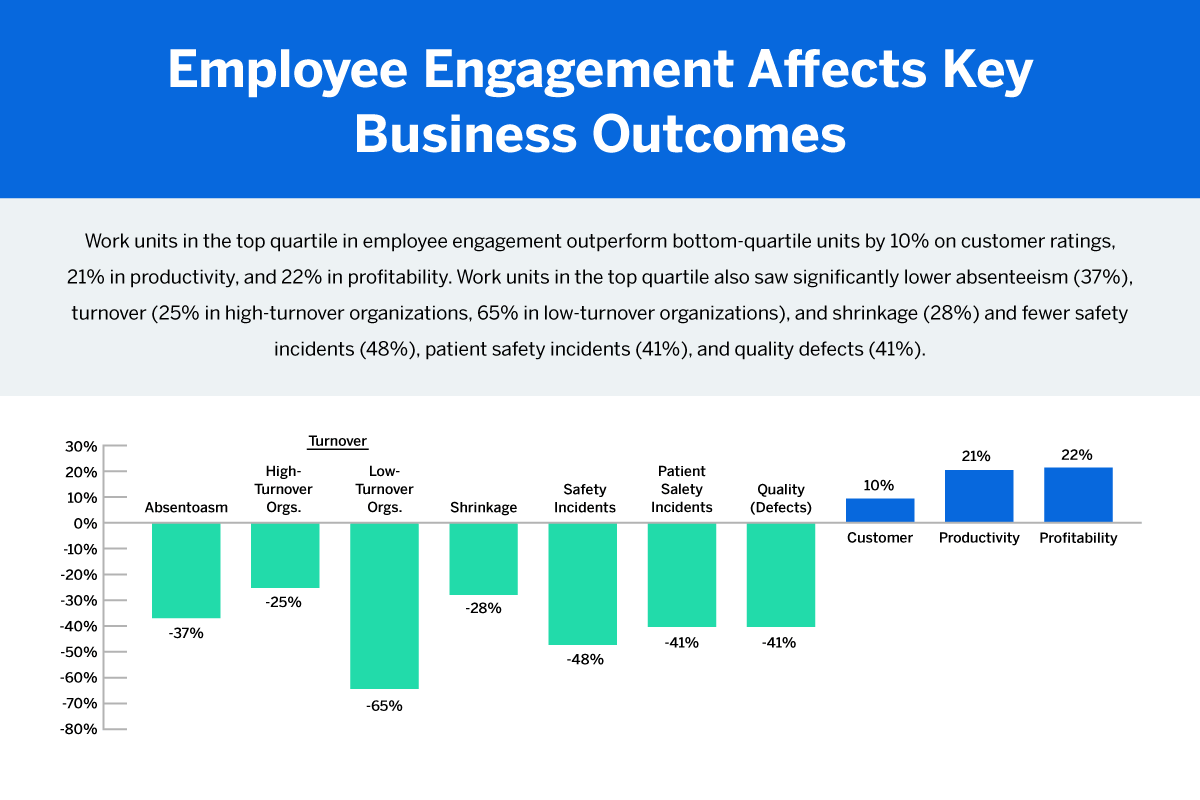
They nurture a culture of belonging
Employees who rarely get a one-on-one with their manager are likely to be disconnected from their organization’s mission and purpose, and they are less likely to feel that they belong. One-on-one meetings are important for nurturing employees, helping them to make the connection between their work contribution and the company achieving its goals.
How to make employees feel comfortable in one on one meetings
Meeting a single person face to face can be a daunting experience for all but the most confident employees. As a manager, it’s your job to put your direct reports at their ease so you – and they – can get the best out of these meetings. There are several things you can do to make your one on ones comfortable – and even enjoyable:
Let your people set their meeting agenda
Agendas for one on one meetings should be collaborative, with employees sharing in advance what they would like to discuss with you. This approach will also give you time to review and prepare constructive responses. Generally, two-way feedback, current goals, recognition for a job well done and career development and aspirations are the most usual topics for a one-on-one agenda. You can create an agenda template to cover all these.
Make it informal
You don’t have to sit in an office facing each other across a desk anymore. You can suggest a walking meeting, a standing meeting, a trip to the coffee shop, or a breakfast meeting. And think of it less as a meeting, more as a discussion where the employee remains the focus. Expect it to be more freeform to cover topics that crop up as you chat.
Make it a regular occurrence
One-off meetings are always slightly disconcerting, whereas a regular, calendar-scheduled meeting becomes part of the expected rhythm of working life. Recurring meetings demonstrate that a manager is invested in each employee and wants to take the time as part of their busy schedule to see them.
Keep it confidential
What is said in the one-to-one meeting between the manager and direct report should remain confidential. Never seek to identify individual responses to feedback.
Listen mindfully
Mindful managers do not simply hear discussions. They actively listen and engage in dialogue, taking note not only of what’s being said but how the person is saying it. Alert body language and make suitable eye contact to ensure the person sitting opposite feels heard.
Keep track
One-on-one meeting topics don’t exist in a vacuum. It’s essential for everybody’s career development that topics are tracked so that actions and outcomes can be measured and improved.
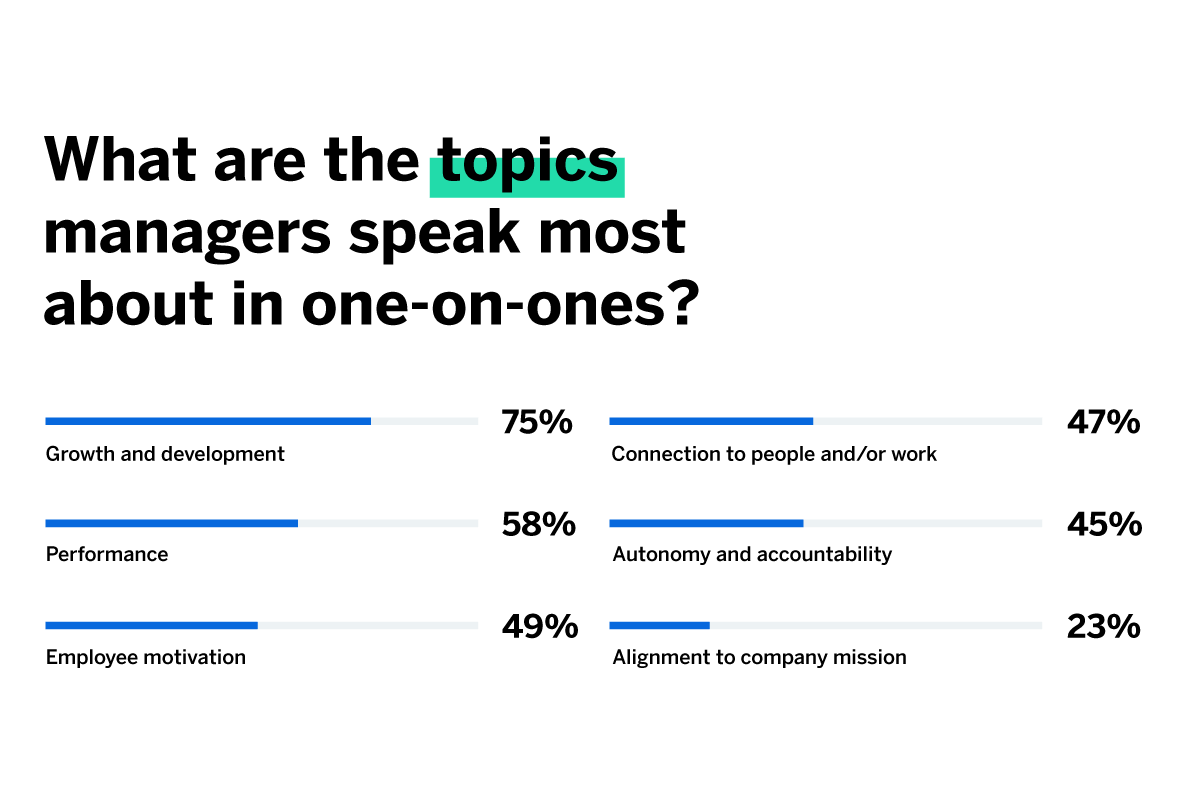
Best practices for effective one-on-one meetings
1. Set a meeting agenda
By setting a meeting agenda in advance, you can ask employees for their input on it. Share the finalized agenda so both parties have advance notice of the talking points you’re going to discuss – you’ll be better prepared and resourced to have a fruitful meeting. That said, be prepared for the conversation to go off in other directions – you don’t have to stick rigidly to the agenda. There’s nothing wrong with a more free-form meeting.
2. Start with a well-being check-in
This needs to be more than a cursory “How are you? How are things?” about the past week. You need to ask open-ended questions that touch on discussion points such as mental and physical health, workload, and personal development:
Well-being
In what ways are they getting mobile and taking breaks?
Are they making use of their allotted time off?
How are they feeling about work currently?
Workload
What does their workload feel like to them and does that match with their assignments?
Is there work that’s lingering on their to-do list?
Are there any side projects that aren’t on their official list, or work where roles are unclear?
Personal development
Spend time defining a meaningful purpose and outlining development goals.
Check-in on progress: ask what kind of barriers can I help clear?
Help re-prioritize as things change or goals are achieved: what tasks are low impact and can be put aside?
3. Priorities and progress towards goals
If this is not the first one-on-one meeting, it needs to be a catch-up on all the pressing issues agreed upon in the previous one on one: what has happened since the last meeting, and what the goals are for the next week.
Team goals
Zoom out to the big picture of what the team does, and link in each employee’s individual goals and how their efforts contribute
Ask the employee how they can share or showcase their work with the team – what lessons have they learned that they can share with others?
What efforts might be going on behind the scenes that they need to know about?
4. Challenges
Nothing ever goes smoothly, and your employee will probably have issues to raise with you. Here, it’s your job to ask what clarity you can provide, and how you can help solve the challenges.
We’re all in it together
Share your own professional journey and the experiences that you’ve had when facing similar challenges.
Identify other team members with relevant knowledge and abilities who can help out.
Point out available support – including training resources, their network of co-workers, mentors, HR team members, or employee assistance benefits.
5. What went well?
Celebrate successes, and challenges overcome, and shout out to the people who helped and supported their colleagues.
Mark milestones
Recognize personal milestones – ask about anniversaries and other dates and times of year that are important to employees.
Cheer on progress towards goals – ask about how you can acknowledge their progress in ways that are meaningful to them.
6. Company business
No employee is an island – what happens in the company and the industry impacts everyone.
The commercial environment
Recap any recent changes or updates – clarify the relevance and meaning of the employee’s work.
Discuss upcoming events or deadlines – ask them if they know where to go for more information.
Pick a recent headline or news article relevant to your business and talk about what it means for them and their work.
Talk about trends you’re both seeing and how you’re experiencing them.
7. Make a commitment or agreement
Before ending your meeting make sure that you both agree to what will be done before the next meeting.
Ask the employee to identify when and how they can practice the behavior change. Accountability increases when given a voice in the agreements.
Balance formal and informal methods here – decide when a verbal agreement will do, when you may want to put something in writing, and when you’d document something in a performance management system.
Often times a brief written message after a conversation can serve as a reminder on both sides for what, where, and when feedback occurred.
What NOT to do in a one-on-one meeting
Cancel it
Unless something truly pressing has come up, avoid canceling one on one meetings. This sends the message that the meeting isn’t important, when in fact, it’s the foundation stone of the relationship with your employee. Reschedule, if you must, as soon as possible, with an apology. By the same token…
Being late or running out of time
Poor time management sends the same signal; that the meeting, and the employee are not important. When people don’t feel they are respected and valued, they disengage, and disengaged employees are inclined to jump ship for a better offer.
Make it a status report update meeting
You can find out all about a project’s progress, with its attendant stats and metrics in a team status updates meeting. A one-on-one meeting is a different beast – it’s all about the individual employee and how they are getting on, so the focus should be on them.
Get distracted by tech
Consider the unspoken messages you’re sending when you glance at your phone or laptop. Instead, be an active listener and make the quality of your interaction your priority. Start by setting your phone and laptop to ‘do not disturb’ to minimize interruptions, and focus on the employee. Use technology sparingly (except when you’re remote working and need it to connect).
Do all the talking
This trait often goes hand in hand with interrupting. And interrupting drives the conversation away from the thread of what your employee wants to say. A one-on-one meeting is all about focusing on listening to your direct report (90% listening and 10% talking, remember).
Make a feedback sandwich
Outdated management practices used to advocate putting negative feedback in between positive feedback. Don’t do this – it obscures and muddles your message about the change you want to see happen. Be balanced and objective; you don’t need to ‘soften the blow’ when you have a great relationship with your reports and you give mutually constructive feedback.
Not asking for feedback
To be effective, constructive feedback has to be two-way – whatever feedback you give, you ask for it in return. How effective are these one-to-ones? Are they time well spent? What would they like to change? Hearing employee feedback is essential for team building and strengthening company culture, and it couldn’t be simpler with a good survey platform.
Failing to make a plan for next time
A one-on-one must have a takeaway – motivation and a task to achieve before the next meeting. Without takeaways, the power of one on one meetings is reduced.
Wondering if you’re doing one on one meetings right?
Great one-on-one meetings contribute to a great employee experience. You can make them even better by using world-class meeting survey software such as Qualtrics. Teams in your organization create feedback dynamics on their day-to-day work and project-specific work. Your employee performance review system may have formal ways to log and track individual goals, but the one-on-one time you spend throughout the year will keep big surprises out of your performance review conversations.
Still not sure if you’re doing one-on-ones the right way? Action idea boards help managers crowdsource ideas from your team on what exactly you should do to improve employee engagement. Managers can create an idea board to send to your teams in Qualtrics.
The idea board is structured around a managers’ focus areas for improvement. Teams can log into the board, give ideas anonymously, and vote on each others’ ideas. After collecting ideas, a manager will have a set of potential solutions for their focus areas that you can act on, and use in your one on ones.
Free eBook: Improve employee experience by empowering your managers
